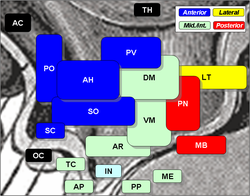Ventromedial nucleus
| Ventromedial nucleus of the hypothalamus | |
|---|---|

Ventromedial nucleus is 'VM', at center, in green.
|
|
| Details | |
| Part of | Hypothalamus |
| Artery | Basilar |
| Identifiers | |
| Latin | nucleus ventromedialis hypothalami |
| MeSH | A08.186.211.730.385.357.352.953 |
| NeuroNames | hier-381 |
| NeuroLex ID | Ventromedial nucleus of hypothalamus |
| Dorlands /Elsevier |
n_11/12584102 |
| TA | A14.1.08.928 |
| FMA | 62332 |
|
Anatomical terms of neuroanatomy
[]
|
|
The ventromedial nucleus of the hypothalamus (VMN, also sometimes referred to as the ventromedial hypothalamus, VMH) is a nucleus of the hypothalamus. "The ventromedial hypothalamus (VMH) is a distinct morphological nucleus involved in feeding, fear, thermoregulation, and sexual activity." This nuclear region is involved with the recognition of the feeling of fullness.
It has four subdivisions:
These subdivisions differ anatomically, neurochemically, and behaviorally.
The ventromedial nucleus (VMN) is most commonly associated with satiety. Early studies showed that VMN lesions caused over-eating and obesity in rats. However, the interpretation of these experiments was summarily discredited when Gold's research demonstrated that precision lesioning of the VMN did not result in hyperphagia. Nevertheless, numerous studies have shown that the immediacy of hyperphagia and obesity syndrome are a consequence of VMN lesions or procaine injections, and point to the VMN's role in satiety. A major review of the subject in 2006 concluded that, "anatomical studies done both before and after Gold's study did not replicate his results with lesions, and in nearly every published direct comparison of VMH lesions vs. PVN or VNAB lesions, the group with VMH lesions ate substantially more food and gained twice as much weight." This strongly substantiates the classification of VMN as the primary satiety center in the hypothalamus.
It has also been found that lesions to the VMH in rats caused increased plasma insulin levels. Rats with a VMH lesion compared to normal rats overproduce a circulating satiety factor, to which the control rats can respond and rats with a VMH lesion cannot respond. A lesion to the VMH makes rats overproduce leptin, which they cannot respond to causing them to over eat, leading to obesity.
Researchers looked at a series of twenty-one animals of various degrees of adiposity, with respect to growth appearance, fat distribution, general physical condition, and the correlation between the level of adiposity attained and the correlation of the hypothalamic lesion. Lesions in the hypothalamic area, particularly the region of the ventromedial hypothalamus interrupts a large number of the descending fibers from the hypothalamic cell groups that were found to contribute to obesity in rats.
Another study found that there seems to be a higher concentration of cannabinoid receptor mRNA within the VMH in comparison to other nuclei within the hypothalamus. The cannabinoid ingestion has been linked to rewarding processes, and also with the release of dopamine in the brain.
...
Wikipedia
